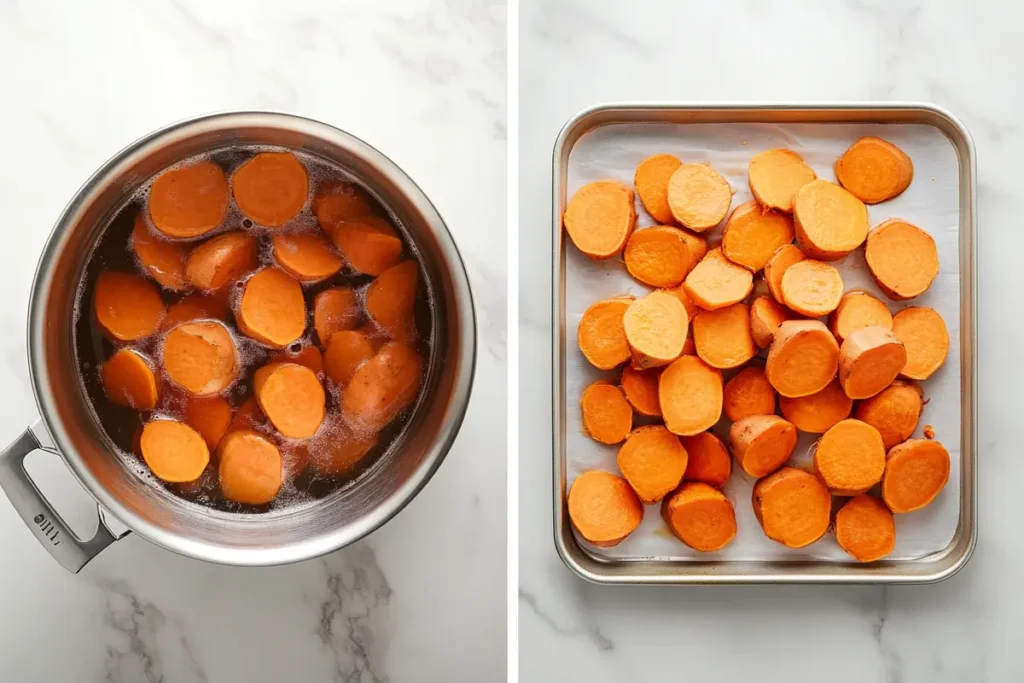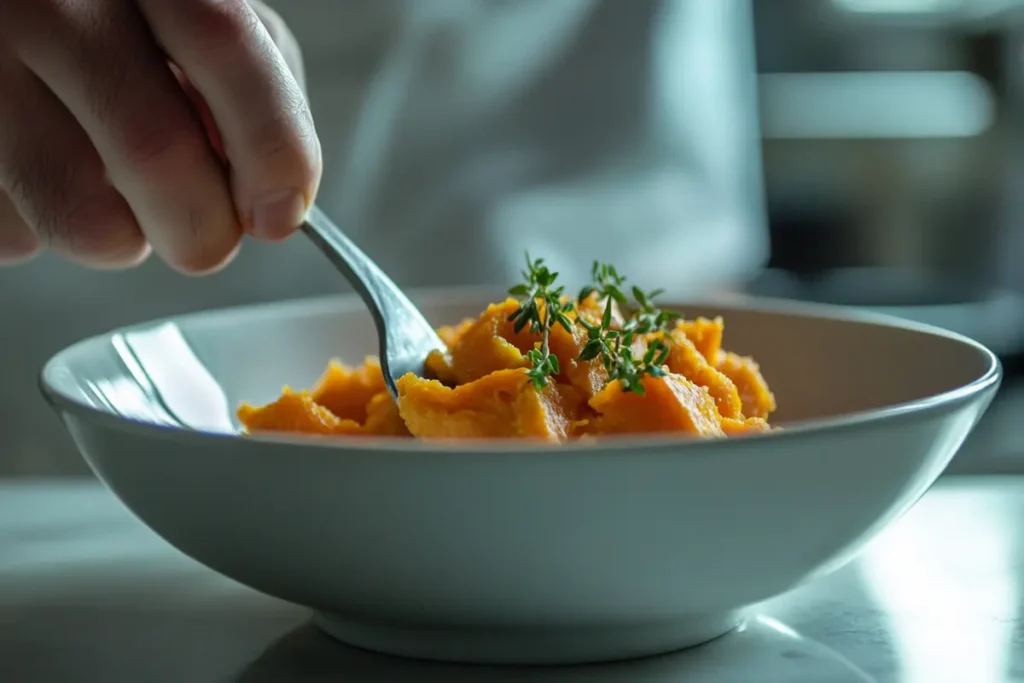Sweet potato casserole boiling vs baking is a key decision when making this dish. The method you choose will change the flavor, texture, and nutrition of your casserole.
The kitchen is warm, filled with the scent of cinnamon and butter. The holiday meal is nearly ready, but one final choice remains—how should you cook the sweet potatoes?
Some say boiling is faster and makes them easier to mash. Others argue that baking enhances natural sweetness and keeps the texture firm. The truth is, the method you choose will affect how your casserole tastes and holds together.
If you want a casserole with deep, caramelized flavor, baking might be the best choice. If you need a quick and easy preparation, boiling could be the way to go. But which one really makes the best Sweet Potato Casserole: Boil or Bake?
By the time you finish reading, you’ll know exactly which method is right for you. You’ll understand how each technique affects taste, texture, and nutrition so that your casserole turns out perfect every time.
If you enjoy cooking with sweet potatoes, you might also want to learn why soaking them before baking can improve their texture. And if you’re wondering whether eggs belong in your casserole, check out this guide on using eggs in sweet potato casserole.
Now, let’s find out whether boiling or baking is the best choice.
What Makes Sweet Potato Casserole So Good
Sweet Potato Casserole: Boil or Bake? This dish is a holiday favorite—smooth, creamy, and just the right amount of sweet. Some people top it with marshmallows, while others prefer pecans or a crunchy streusel.
No matter which topping you choose, the most important part of the dish is the sweet potatoes. If they are not cooked properly, the casserole will not turn out right.
The two most common ways to cook sweet potatoes for a casserole are boiling and baking.
Let’s look at what happens with each method.
Sweet Potato Casserole Boiling vs Baking – Is Boiling Better

Boiling is one of the quickest ways to cook sweet potatoes. It softens them fast, making them easy to mash.
How to Boil Sweet Potatoes
- Peel the sweet potatoes and cut them into small, even-sized chunks.
- Put them in a pot and cover them with water.
- Bring the water to a boil. Then reduce the heat and let them simmer for 10 to 15 minutes.
- Once they are soft, drain the water completely.
- Mash them and use them in your casserole.
Sweet Potato Casserole Boiling vs Baking – Pros and Cons of Boiling
What’s Good About Boiling
- It’s fast. Sweet potatoes are ready in about 15 minutes.
- It’s easy. You don’t need to check on them much while they cook.
- They mash smoothly. The texture is very soft and blends well with other ingredients.
What’s Bad About Boiling
- They lose some nutrients. Vitamins like vitamin C and B vitamins go into the water.
- They can be too wet. Sweet potatoes absorb water, which can make the casserole runny.
- They lose some sweetness. Some of the natural sugar washes away in the water.
Sweet Potato Casserole Boiling vs Baking – Is Baking Better
Baking takes longer, but it brings out the best flavor in sweet potatoes.
How to Bake Sweet Potatoes
- Wash the sweet potatoes and pat them dry.
- Prick them a few times with a fork.
- Place them on a baking sheet.
- Bake at 400°F (200°C) for 45 to 60 minutes.
- Let them cool slightly, then scoop out the soft inside and mash.
Sweet Potato Casserole Boiling vs Baking – Pros and Cons of Baking
What’s Good About Baking
- They taste better. Baking caramelizes the natural sugars, making them sweeter.
- They have a firmer texture. This makes the casserole more structured and less mushy.
- They keep more nutrients. Baking helps retain more vitamins and minerals.
What’s Bad About Baking
- It takes longer. Baking can take nearly an hour.
- It needs oven space. This can be a problem if you’re making other dishes at the same time.
- Some parts may cook unevenly. If the potatoes are different sizes, some may be softer than others.
Sweet Potato Casserole Boiling vs Baking – Which Method is Best
The method you choose—boiling or baking—directly impacts the flavor, texture, and nutrition of your sweet potato casserole boiling vs baking dish. Understanding these differences is key to achieving the perfect casserole consistency and taste.
In this guide, we’ll compare sweet potato casserole boiling vs baking to help you determine the best cooking method based on your time, texture preference, and nutritional goals.
Sweet Potato Casserole Boiling vs Baking – Side-by-Side Comparison
| Factor | Boiling | Baking |
|---|---|---|
| Time | 15–20 minutes | 45–60 minutes |
| Flavor | Mild, some sweetness lost | Deep, caramelized sweetness |
| Texture | Soft, smooth, sometimes watery | Firm, rich, holds shape |
| Nutrient Retention | Some vitamins lost | More nutrients kept |
Baking is better for flavor and texture. Boiling is faster and easier.
Sweet Potato Casserole Boiling vs Baking – How It Affects Texture and Flavor
- Texture: Baking gives the casserole a firmer, more structured texture. Boiling makes it softer and smoother.
- Flavor: Baked sweet potatoes caramelize, creating a naturally rich sweetness. Boiled potatoes may require extra sugar to enhance flavor.
- Nutrition: Baking preserves more vitamins and minerals, while boiling can cause nutrient loss in water.
By choosing the right method, you can achieve the perfect balance of texture, flavor, and health benefits in your sweet potato casserole.
Nutritional Comparison: Which Method is Healthier
Sweet potatoes are packed with fiber, vitamin A, potassium, and antioxidants. However, the cooking method can impact their nutritional profile.
| Nutrient | Boiled Sweet Potatoes | Baked Sweet Potatoes |
|---|---|---|
| Vitamin A | Retained well | Retained well |
| Vitamin C | Some loss in water | Retained |
| B Vitamins | Some loss in water | Retained |
| Potassium | Some leached into water | Retained |
Winner: Baking retains more nutrients overall.
Sweet Potato Casserole Boiling vs Baking – Which Method is Faster?
| Method | Prep Time | Cook Time | Total Time |
| Boiling | 5 min | 10–15 min | 15–20 min |
| Baking | 5 min | 45–60 min | 50–65 min |
If you’re short on time, boiling is the faster option. However, if you’re prepping in advance, baking might be worth the wait for better flavor.
Step-by-Step Sweet Potato Casserole Recipe
Ingredients:
- 3 large sweet potatoes (boiled or baked)
- 4 tbsp butter, melted
- ¼ cup brown sugar (adjust to taste)
- ½ cup milk
- 1 tsp cinnamon
- ½ tsp nutmeg
- 1 tsp vanilla extract
- 2 eggs, beaten
- Topping: Marshmallows, pecans, or streusel
Instructions for Sweet Potato Casserole

- Prepare the sweet potatoes. Boil or bake them based on your preference, then mash them until smooth.
- Mix the ingredients. In a large bowl, combine the mashed sweet potatoes with melted butter, sugar, milk, cinnamon, nutmeg, vanilla extract, and beaten eggs. Stir until well blended.
- Transfer to a baking dish. Spread the mixture evenly in a greased baking dish to ensure even cooking.
- Add the toppings. Sprinkle chopped pecans for a crunchy texture or top with marshmallows for a sweet, gooey finish.
- Bake the casserole. Place the dish in a preheated oven at 375°F (190°C) and bake for 25–30 minutes until golden brown.
- Serve warm. Let it cool slightly, then enjoy as part of your holiday meal.
Common Mistakes When Making Sweet Potato Casserole
Even simple recipes can go wrong with small mistakes that affect flavor, texture, or consistency. Avoiding these common errors will help ensure a perfectly balanced, smooth, and flavorful sweet potato casserole every time.
1. Using Too Much Liquid
Sweet potatoes naturally contain moisture, and adding too much milk, cream, or butter can make the casserole overly soft or watery. This issue is especially common when using boiled sweet potatoes, as they absorb water during cooking.
How to Fix It: If boiling sweet potatoes, drain them thoroughly before mashing. If baking, add liquid gradually rather than all at once to prevent excess moisture.
2. Overmixing the Sweet Potatoes
Overmixing mashed sweet potatoes can lead to a gummy, gluey texture instead of the light and creamy consistency you want. This happens because excessive mixing releases too much starch.
How to Fix It: Mash the sweet potatoes just until smooth using a potato masher or hand mixer. If using a food processor, pulse briefly rather than blending continuously.
3. Skipping Eggs or Not Mixing Them Properly
Eggs help bind the casserole, adding structure and preventing it from being too soft or falling apart. However, adding them directly to hot mashed sweet potatoes can cause them to scramble.
How to Fix It: If using eggs, whisk them separately and let the mashed sweet potatoes cool slightly before mixing them in. This ensures even distribution and a smooth texture.
4. Making It Too Sweet
Sweet potatoes already have natural sugars, and adding too much brown sugar, maple syrup, or honey can make the casserole overly rich and cloying.
How to Fix It: Taste the mashed sweet potatoes before adding sugar. If they were baked, they will already be sweeter than boiled ones, so you may need less sweetener.
Sweet Potato Casserole Boiling vs Baking – Final Decision
Choose Boiling If:
- You want to cook the sweet potatoes quickly.
- You like a softer, smoother texture.
- You don’t mind adding extra sweeteners to improve flavor.
Choose Baking If:
- You want deeper, caramelized flavor.
- You prefer a firmer, more structured casserole.
- You want to keep more nutrients.
Both methods work, but baking gives the best results in terms of taste, texture, and nutrition.
FAQs – Sweet Potato Casserole Boiling vs Baking
Is it better to boil or bake sweet potatoes for a casserole?
Generally, baking sweet potatoes is better for a casserole. Baking enhances the natural sweetness. Additionally, it creates a drier texture. However, boiling is faster if you’re short on time.
Is baking sweet potato better than boiling?
Yes, baking sweet potatoes is usually better than boiling. Baking helps keep more of their nutrients. It also brings out a richer flavor. Therefore, it is the preferred method for many.
What is the best cooking method for sweet potatoes?
The best cooking method depends on the dish. For casseroles, baking is generally preferred. For other dishes, boiling may be suitable. Therefore, think about what you are trying to make.
Is it better to bake or boil sweet potatoes for pie?
For sweet potato pie, baking sweet potatoes is often recommended. Baking gives the pie a richer, sweeter taste. It also keeps the texture from becoming too watery. Consequently, many cooks choose to bake them.
Sweet Potato Casserole Boiling vs Baking – Final Thoughts
If you want the best sweet potato casserole, baking is the way to go. It takes longer, but the flavor, texture, and nutrition are worth it.
If you are short on time, boiling works too. Just be careful to drain the potatoes well so your casserole is not too watery.
No matter which method you choose, your sweet potato casserole will be delicious and loved by everyone at the table.
Print
Sweet Potato Casserole Boiling vs Baking – Best Cooking Method
Description
- A classic holiday sweet potato casserole, made with creamy mashed sweet potatoes, warm spices, and a delicious topping of marshmallows or pecans. Whether you choose to boil or bake the sweet potatoes, this dish is a comforting and flavorful favorite.
Ingredients
- 3 large sweet potatoes (boiled or baked)
- 4 tbsp butter, melted
- ¼ cup brown sugar (adjust to taste)
- ½ cup milk
- 1 tsp cinnamon
- ½ tsp nutmeg
- 1 tsp vanilla extract
- 2 eggs, beaten
- Topping: Marshmallows, pecans, or streusel
Instructions
-
Prepare the sweet potatoes
- Boil or bake the sweet potatoes based on your preference.
- Once cooked, mash them until smooth in a large bowl.
-
Mix the ingredients
- Combine the mashed sweet potatoes with melted butter, brown sugar, milk, cinnamon, nutmeg, vanilla extract, and beaten eggs.
- Stir until the mixture is smooth and well blended.
-
Transfer to a baking dish
- Grease a baking dish and spread the sweet potato mixture evenly to ensure even cooking.
-
Add the toppings
- Sprinkle chopped pecans for a crunchy texture.
- If using marshmallows, evenly distribute them over the top.
-
Bake the casserole
- Preheat the oven to 375°F (190°C).
- Bake for 25–30 minutes or until golden brown.
-
Serve warm
- Allow the casserole to cool slightly before serving.
- Enjoy as a delicious side dish for your holiday meal!
Notes
- If using boiled sweet potatoes, drain them thoroughly before mashing to avoid excess moisture.
- Avoid overmixing to prevent a gummy texture.
- If using eggs, let the mashed sweet potatoes cool slightly before adding them to avoid scrambling.
- Taste the mixture before adding sugar—baked sweet potatoes tend to be naturally sweeter.

